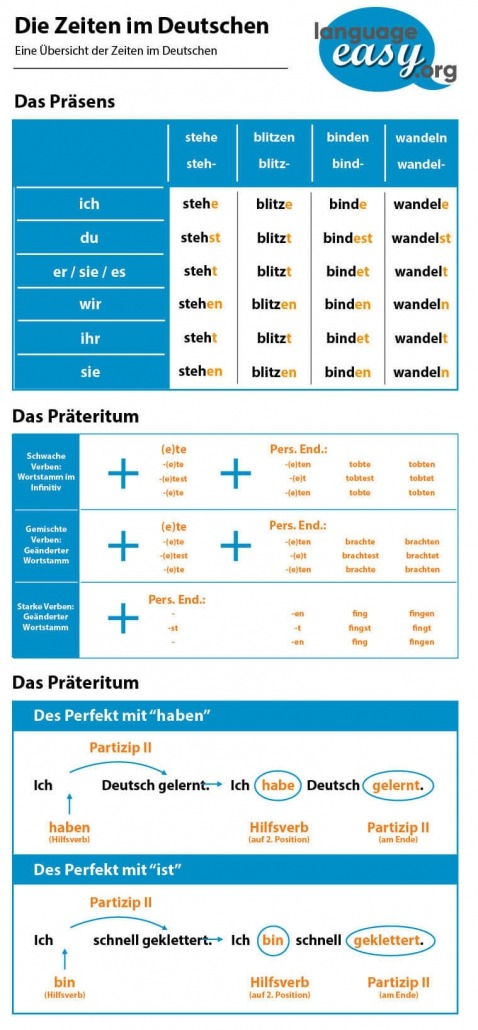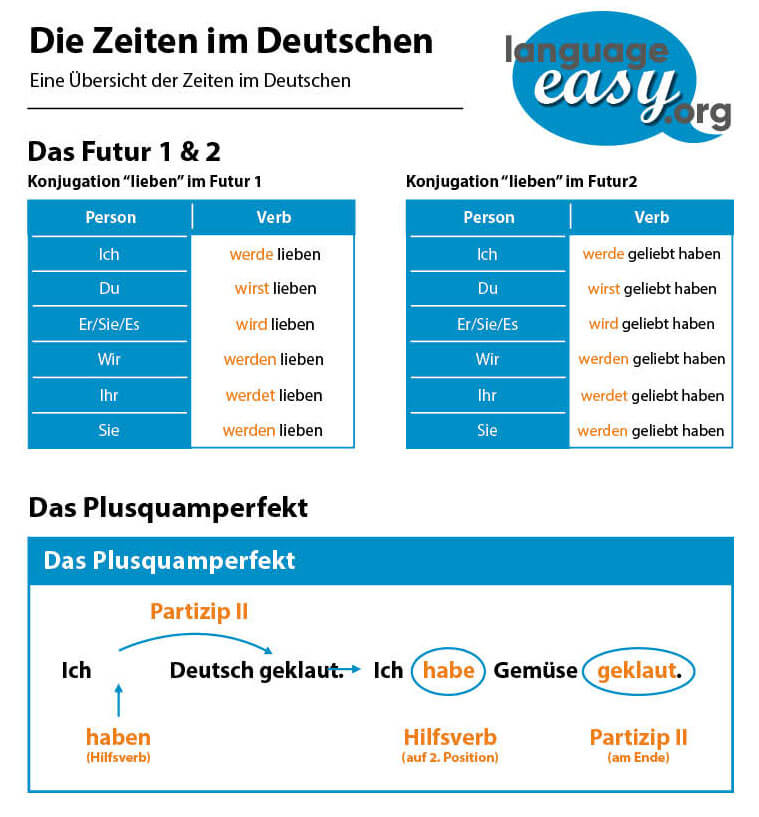German Tenses
Die Zeiten im Deutschen – Erklärungen und Beispiele
German Tenses – Summary
Zusammenfassung
Present Tense
The present tense is probably the most common tense used in German. It is used for actions which…
- … take place at the moment you are speaking
- … are timeless
- … repeat themselves
The present tense is formed by adding the corresponding ending (-e, -st, -t, -en, -t, -en) to the word stem of the verb. There are some vowel changes when going from first to second to third person. Just have a look at the following examples:
- “ich laufe – du läufst – er läuft”
- “ich trage – du trägst – er trägt”
The vowel of the stem changes from “e” to “i“.
- “ich sehe – du siehst – er sieht”
- “ich trete – du trittst – er tritt”
In case the stem ends with “-s“, the ending of the second and the third person are the same.
- “lesen”: “du liest – er/sie/es liest”
The Perfect Tense
By using verbs in the perfect tense you express that an action has taken place before the present and is part of the past. In many cases, this action has a connection with the present. The present tense is a compound tense. That means that you build it by using the present tense form of the auxiliary verb (“haben” or “sein“) and the participle 2 of the main verb.
The following groups of verbs are built with the auxiliary verb “haben“:
- Transitive verbs: “Ich habe dich gesehen.”
- Modal verbs: “Ich habe gekonnt.”
- Reflexive verbs: “Ich habe mich erinnert.”
How to form the participle 2:
- Participle 2 of regular verbs: “ge”+ stem + “t” (“ge-lern-t”)
- Participle 2 of irregular verbs: “ge”+ stem + “en” (“ge-gang-en”)
- Verbs with fixed prefixes don’t use “ge-“: (“verschwunden, zerrissen”)
- In case there are separable prefixes, “-ge-“ is introduced: (“aus-ge-kommen, fort-ge-laufen”)
The Past Tense
By using a verb in the past tense, you express an action that took place in the past. The past tense is normally used for reports or tales – so, especially for literature. In spoken language, people prefer using the perfect tense to express actions of the past.
When regular verbs are expressed in the past tense, there is a “-t-” inserted after the stem. In case the stem ends with “-d” or “-t“, you insert an extra “-e-“. Here are some examples:
- “spielen“: “ich spiel-t-e, du spiel-t-est, er/sie/es spiel-t-e, wir spiel-t-en, ihr spiel-t-et, sie spiel-t-en.”
- “reden“: “ich red-et-e, du red-et-est, er/sie/es red-et-e, wir red-et-en, ihr red-et-et, sie red-et-en.”
- “spotten“: “ich spott-et-e, du spott-et-est, er/sie/es spott-et-e, wir spott-et-en, ihr spott-et-et, sie spott-et-en.”
Irregular verbs in past tense have their stem changed. The first and the third person don’t have an extra ending.
- “fallen“: “ich fiel, du fiel-st, er/sie/es fiel, wir fiel-en, ihr fiel-t, sie fiel-en.”
- “geben“: “ich gab, du gab-st, er/sie/es gab, wir gab-en, ihr gab-t, sie gab-en.”
- “singen“: “ich sang, du sang-st, er/sie/es sang, wir sang-en, ihr sang-t, sie sang-en.”
The Past Perfect
In case an action took place before an action in the past, you use the past perfect tense for the verb. You build this tense by expressing the auxiliary verb (either “haben” or “sein”) in the past tense and the main verb in its participle 2 form. So, the auxiliary verb “sein” is turned into “war” and “haben” into “hatte“.
- “Ich hatte gesehen, du hattest gesehen, er/sie/es hatte gesehen, wir hatten gesehen, ihr hattet gesehen, sie hatten gesehen.”
- “Ich war gegangen, du warst gegangen, er/sie/es war gegangen, wir waren gegangen, ihr wart gegangen, sie waren gegangen.”
The Future Tenses
1. Future 1
By using the future 1, you express an action that will take place in the future. Forming this tense is quite simple: You just use the auxiliary verb “werden” and put the infinitive of the main verb after it.
- “gewinnen“: “ich werde gewinnen, du wirst gewinnen, er/sie/es wird gewinnen, wir werden gewinnen, ihr werdet gewinnen, sie werden gewinnen.”
- “verlieren“: “ich werde verlieren, du wirst verlieren, er/sie/es wird verlieren, wir werden verlieren, ihr werdet verlieren, sie werden verlieren.”
2. Future 2
The future 2 tense is not used too frequently in German. Nevertheless, you use verbs in this tense for expressing that an action will have happened in the future. You build it by using the auxiliary verb “werden”, the participle 2 of the main verb and another auxiliary verb, “haben” or “sein”.
- “Morgen werde ich mein ganzes Geld verloren haben.”
- “Bald werden noch weitere Pflanzen ausgestorben sein.”
Welcome to language-easy.org! So, as you have clicked on this article, you want to know some more about German tenses. Well, you reached one of the most important part of this language, as tenses but also moods give you the ability to polish your German. Furthermore, it enables you to express wishes, improves your story telling and simply makes you sound like a real German mother tongue.
Of course, the crucial importance of German tenses is quite clear. But you also have to consider the different moods! Whether you want to wish, give order or you try to express something you are not really sure about… Moods in combination with German tenses give you a huge variation of expressing yourself.
Well, in this article I would like to give you an overview of German tenses and moods. So, we will now go into too many details. Nevertheless, you will have some buttons at the bottom of this article which will lead you to more detailed article about every German tense or mood.
Tabular Overview of German Tenses and Moods
Tabularische Übersicht über Zeiten und Modi im Deutschen
First of all, we will have a look at German tenses and moods in some tables. So, for this we will use the German word “machen” (to do) in the first person singular. Please, keep in mind that there are tenses in German which don’t exist in this form in the English language. Nevertheless, most of them are quite similar. So, let’s go straight ahead to our first table. By the way – don’t panic if you don’t know everything about every German tense or mood in these tables – later on, we will explain them.

Unfortunately, German tenses are not exactly the same as in English. So, you can find the differences especially in the way one uses them. In particular, “Präsens” and “Perfekt” are the tenses for present and past. Of course, you know that their use in the English language is somewhat different.
The Description of German Moods
Die Beschreibung der Modi im Deutschen
So, let’s talk about the moods we have seen in the tables above. They are a little bit easier to describe, so we will start with them.
- First, the “Indikativ” is the ‘normal’ and so most commonly used mood used in English as well as in German. Well, you simply use it to describe the reality! Or just to express it in an easier way: Things which happen, happened, will happen or are expected to happen.
- Second, you use the “Konjunktiv 1” in indirect or reported speech. Mostly, it appears in German news reports. Well, this mood is not really of high importance, as you normally don’t use it in written or spoken language. By the way, there is no real counterpart in the English language.
- Third, the “Konjunktiv 2” is the more popular type and can be compared to the conditional mood in the English language. Of course, you all know that it describes things that might happen. And there is another similarity to the English conditional mood: You can replace the auxiliary verb “would” by a form of “werden” in German.
- Fourth and last, the “Imperativ” is the form that expresses orders. Luckily, you just have to learn the second person form of a verb in present tense and you are done.
Although “Konjunktiv 1” is not a really important mood, you will have to suffer from it in German classes anyway. And as there is no comparison to the English subjunctive or conditional, there is no other way to master this topic than learn and practice.
The Description of German Tenses
Die Beschreibung der Zeiten im Deutschen
Now, let’s come to the most important part of this article. So, German tenses are actually quite comparable to the tenses in the English language. Nevertheless, there are differences in their use, as already mentioned above. So, here are the descriptions of German tenses.
Present Tense
First, the “Präsens” is comparable to the simple past in the English language. Of course, it represents also other tenses of English. On the one hand, you can use it like the continuous forms we use in English. On the other hand, it can also express a type of future actions. Well, in this case you call it futuristic present and it has its equivalent in English. Nevertheless, German speakers use it more frequently in everyday language.
Simple Past and Perfect
Second, “Präteritum” and “Perfekt” are the two tenses that German speakers use to express actions in the past. But, as I have already mentioned, forms of Präteritum are not so common as forms of Perfekt. Nevertheless, learn the forms of Präteritum. Well, this German tense still occurs in some written and spoken language and its forms can sometimes be complicated.
Plusquamperfekt
Third, you can compare the “Plusquamperfekt” directly to the past perfect in the English language. So, this German tense, as well as the English one, expresses actions which are already completed in some point of the past.
Futur 1
Fourth, we have the “Futur 1”. Like other German tenses, you can also compare it directly to its equivalent in English, the future tense. Luckily, there are no other forms of future tense in German, although you have to keep in mind that there is the futuristic present.
Futur 2
Fifth and last, the “Futur 2” has its direct equivalent in the English language in the future perfect tense. Of course, it also describes actions that will be completed in future actions.
Well, that’s it! Hopefully, I could give you a short overview of German tenses and moods. So, as I already told you.




